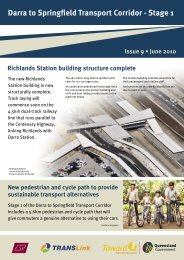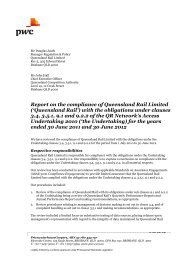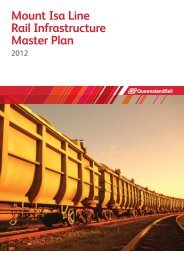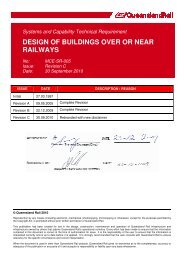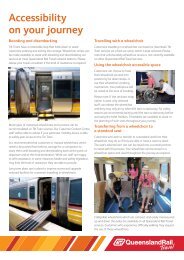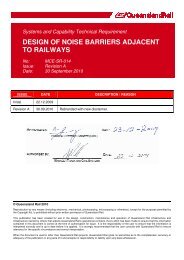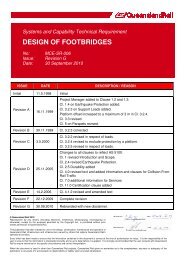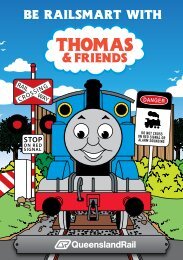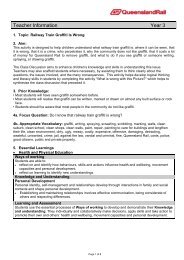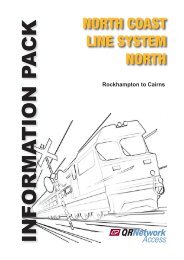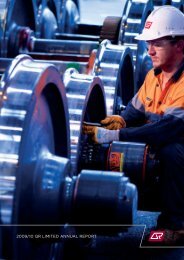North Coast Line South Information Pack - Queensland Rail
North Coast Line South Information Pack - Queensland Rail
North Coast Line South Information Pack - Queensland Rail
You also want an ePaper? Increase the reach of your titles
YUMPU automatically turns print PDFs into web optimized ePapers that Google loves.
Code of Practice for <strong>Rail</strong>way Noise Management<br />
Noise is recognised as a form of environmental nuisance in the Environment<br />
Protection Act. QR intends to meet its general environmental duty with respect to<br />
noise by implementing it’s Code of Practice for <strong>Rail</strong>way Noise Management (“the Noise<br />
Code”).<br />
The purpose of the Noise Code is to provide a means by which QR can demonstrate it<br />
is taking reasonable and practicable measures to minimise unreasonable interference<br />
with the acoustic amenity of neighbouring noise-sensitive communities from QR’s<br />
railway activities.<br />
The Noise Code is a self imposed set of rules for carrying out all QR railway<br />
activities.<br />
It is not intended to manage the noise impacts of a third party’s operational activities.<br />
It is to be made available to third parties operating trains on QR infrastructure to the<br />
extent that its terms are reasonably applicable to those operators. It is expected that<br />
all <strong>Rail</strong> Operators will abide by the Code.<br />
The Noise Code is available upon request and is also available via QR’s Internet web<br />
site at www.qr.com.au under Corporate Documents.<br />
Wheel Squeal & Flanging<br />
Wheel Squeal is caused by friction forces between the top of rail and wheel interface.<br />
Whereas, flanging noise is predominantly caused by friction forces between the side<br />
of rail and wheel interface. Continuous or sustained wheel squeal produced primarily<br />
on the low rail side, is distinct from discontinuous “flanging noise” that is produced on<br />
the high rail side. Continuous wheel squeal is of a high level, and QR’s experience is<br />
that it may cause significant community reaction, while flanging noise is of a lower level<br />
and is more accepted by the community.<br />
Generally, tighter radius curves (i.e. under 300 metre radius) when associated with a<br />
number of rollingstock factors that promote wheel squeal, may result in squeal being<br />
produced. Rollingstock factors that may promote wheel squeal include:<br />
• Higher wheel hardness<br />
• Stiff primary suspensions<br />
• High centre plate friction<br />
• Worn wheel treads<br />
• Misaligned axles<br />
• Unmatched wheel tread diameters, and<br />
• Incorrectly adjusted sidebearers<br />
Noise Complaints<br />
QR is corporately committed to act towards its neighbours in a considerable and<br />
reasonable manner. This good neighbour commitment assumes a reasonable<br />
degree of tolerance from neighbours and a commitment by QR to take action where<br />
appropriate.<br />
Where QR receives complaints about noise from railway activities for which QR may be<br />
responsible, QR responds to those complaints and maintains records of those complaints<br />
in accordance with its Environmental Management System (EMS).<br />
NORTH COAST LINE SYSTEM - SOUTH - INFORMATION PACK<br />
(Nambour - Gladstone and Rocklands to Rockhampton)<br />
ISSUE 2 - JUNE 2007 - 21



